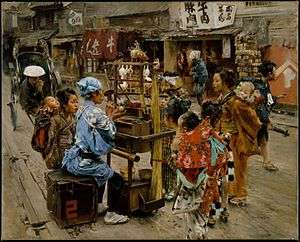The Ameya
The Ameya, also known as The Candy Blower, is a late 19th-century painting by American artist Robert Frederick Blum. Done in oil on canvas, the illustration depicts a Japanese candy maker (practicing the art of Amezaiku) at work. The Ameya is in the collection of the Metropolitan Museum of Art.
| The Ameya | |
|---|---|
| The Candy Blower | |
 | |
| Artist | Robert Frederick Blum |
| Year | c. 1893 |
| Medium | Oil on canvas |
| Dimensions | 63.7 cm × 78.9 cm (25.1 in × 31.1 in) |
| Location | Metropolitan Museum of Art, New York City |
| Accession | 04.31 |
Description
In 1890, Scribner’s Magazine dispatched American painter Robert Frederick Blum to Japan to illustrate a series of articles (written by Sir Edwin Arnold)[1] the magazine was publishing. Blum occupied a small house in Toyko for two years, and traveled through the country in search of scenes to illustrate.[2][1]
The Ameya was created by Blum during the later period of his stay in Japan. The work depicts an ameya, a candy maker practicing the art of Amezaiku; Blum himself described the ameya's work as being akin to glassblowing.[2]
Following his return to the United States, Blum's work was well received, particularly at the 1893 exhibition of the National Academy of Design[3]—Blum later credited The Ameya with securing his election to the Academy.[4] A critic for the New York Times praised the work's use of multiple subjects in varied dress, and described it as being "admirably painted".[3] Other sources have cited Ameya as being an example of Blum's ability to convincingly render groups of figures in his illustrations.[3]
The painting was once owned by Alfred Corning Clark, whose estate donated it to the Metropolitan Museum of Art in 1904.[2]
References
- Meech-Pekarik, Julia (1982). Early Collectors of Japanese Prints and The Metropolitan Museum of Art. The Metropolitan Museum Journal. p. 103.
- "The Ameya". www.metmuseum.org. Retrieved 2019-09-27.
- N.Y.), Metropolitan Museum of Art (New York; Caldwell, John; Bolger, Doreen; Roque, Oswaldo Rodriguez; Spassky, Natalie (1980). American Paintings in the Metropolitan Museum of Art. Metropolitan Museum of Art. ISBN 9780870992445.
- New Metropolitan. Blakely Hall. 1904.